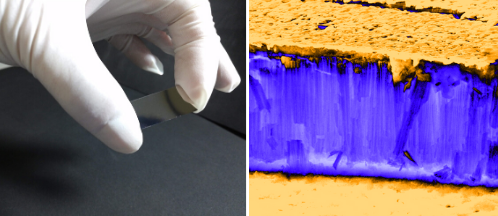
At the left, a sample of the new flexible antiferromagnetic material (ICMAB-CSIC). At the right, SEM image of the flexible tapes section (Ignasi Serra, ICMAB-CSIC).
Cerdanyola del Vallès, 30 March 2020. Researchers from the Institute of Materials Science (ICMAB-CSIC), in collaboration with the ALBA Synchrotron, have designed new flexible and crystalline tapes made of an antiferromagnetic material. This innovation, which is published in the journal Applied Materials & Interfaces, allows the recording of magnetic information in a more secure and robust way, and could be integrated in flexible or wearable devices, such as credit or identification cards.
Antiferromagnetic materials offer a more robust alternative for storing information than ferromagnetic materials (the most widely used today to encode information, for example, on magnetic cards).
"Ferromagnets have been known for thousands of years and their behavior has been extensively studied. Antiferromagnetics, in which the magnetic moments of the atoms are spontaneously aligned antiparallel to the neighboring moments, can be used to store information, following certain protocols, providing greater security than ferromagnets", explains Ignasi Fina, ICMAB-CSIC researcher and first author of the article.
The iron-rhodium alloy (FeRh) is one of the antiferromagnetic materials that can display these characteristics. Moreover, its antiferromagnetic arrangement is especially easy to manipulate thanks to the fact that it presents a transition from antiferromagnetic to ferromagnetic at a temperature near above room temperature.
Until now FeRh materials had not been integrated in conventional flexible devices (grown on polymeric substrates), because they need to show a good crystallinity (atoms arranged in a certain order) that allows stabilizing the antiferromagnetic ordering. The FeRh alloys are usually prepared on monocrystalline substrates, which makes them rigid and potentially fragile.
A flexible material with a crystalline structure
"It is especially difficult to obtain a flexible material with a crystalline structure. Since the properties of the materials utterly depend on their structure, it is very important to obtain the material with a good crystallinity, which is what gives FeRh its unique properties for data recording," adds Ignasi Fina.
The study proofs the robustness of the magnetic properties of the material under bending, and the information storage in the tapes, which could be fabricated in meters-long tape, proving its affordable and feasible scale up.
"These flexible antiferromagnetic tapes have multiple applications in secure and robust magnetic recording, and could be integrated in real flexible or wearable devices, such as credit cards or identification cards, where security and robustness against electromagnetic radiation, for example from cell phones, is extremely important. Other possible niche applications arelikely to emerge when suitable prototypes become available" concludes the ICMAB researcher.
Some of the experiments were performed at the CIRCE beamline of the ALBA Synchrotron. More specifically, researchers studied the ferromagnetic domain distribution at high temperature (T = 150 ºC) collected by X-Ray Magnetic Circular Dichroism in combination with Photoemission Electron Microscopy (XMCD-PEEM).
The research team will continue to work on this idea within the framework of an AGAUR/FEDER/GenCat project awarded in the LLAVOR 2019 call.
Reference: Ignasi Fina, Nico Dix, Enric Menéndez, Anna Crespi, Michael Foerster, Lucia Aballe, Florencio Sánchez, Josep Fontcuberta. Flexible Antiferromagnetic FeRh Tapes as Memory Elements. ACS Appl. Mater. DOI: 10.1021/acsami.0c00704




